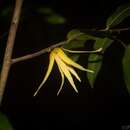mk
имиња во трошки


Meiogyne is a genus of flowering plants with about 33 species[1] belonging to the family Annonaceae. It is native from southwestern India and Indochina to Australia, including Fiji and New Caledonia.
Trees or shrubs with pale straw coloured twigs. Leaves membraneous and with prominent veins. Flowers axillary, medium to large. Sepals 3, valvate, connate at base. Petals 6, valvate in two series, tapering gradually from a broad base upward and diverging, densely tomentose or sericeous-tomentose. The inner petals are slightly shorted in length with a warted patch at base inside. Stamens numerous with flat-topped slightly oblique connective tissue, concealing the anther lobes with viewed from above. Torus convex. Ovaries 2 to 5 with several ovules in two rows. Stigma discoid, sessile. Carpels thick-walled, sessile or sub-sessile.
Meiogyne is different from Cyathocalyx in several ways. The leaf texture is different. Flowers are axillary and not extra-axillary or leaf-opposed. Arrangement of the petals is diverging from a broad base and not clawed and constricted and the base is not adpressed over the stamens. The warted base of the inner petal is peculiar. The stamens and stigmas are similar to Cyathocalyx. Meiogyne is similar to Polyalthia in its spreading petals and similarity of stamens, but the large number of seeds and sessile, discoid stigma are distinguishing features.[2]
As of January 2023 Plants of the World Online includes the following 33 species:[1]
Meiogyne is a genus of flowering plants with about 33 species belonging to the family Annonaceae. It is native from southwestern India and Indochina to Australia, including Fiji and New Caledonia.
Meiogyne es un género de plantas fanerógamas con 24 especies[1] perteneciente a la familia de las anonáceas. Son nativas del sur y sudeste de Asia hasta Australia.[2]
Son arbustos o árboles, con pelos simples. Las hojas con las venas secundarias oblicuas muy juntas. Las inflorescencias axilares. Flores bisexuales. Sépalos 3, valvados, unidos en la base. Pétalos 6, en 2 verticilos. Frutos monocarpos 1-3 [-5], generalmente sésiles, ovoides. Semillas de varias a muchas por monocarpo.[3]
El género fue descrito por Friedrich Anton Wilhelm Miquel y publicado en Annales Museum Botanicum Lugduno-Batavi 2: 12. 1865.[4] La especie tipo es: Meiogyne virgata (Blume) Miq.
Meiogyne es un género de plantas fanerógamas con 24 especies perteneciente a la familia de las anonáceas. Son nativas del sur y sudeste de Asia hasta Australia.
Meiogyne Miq. – rodzaj roślin z rodziny flaszowcowatych (Annonaceae Juss.). Według The Plant List w obrębie tego rodzaju znajduje się 12 gatunków o nazwach zweryfikowanych i zaakceptowanych, podczas gdy kolejne 4 taksony mają status gatunków niepewnych (niezweryfikowanych)[3]. Występuje naturalnie w klimacie tropikalnym na obszarze od Azji Południowo-Wschodniej po Oceanię[4][5]. Gatunkiem typowym jest M. virgata (Blume) Miq.[2]
Rodzaj wraz z całą rodziną flaszowcowatych w ramach rzędu magnoliowców wchodzi w skład jednej ze starszych linii rozwojowych okrytonasiennych określanych jako klad magnoliowych[1].
Meiogyne Miq. – rodzaj roślin z rodziny flaszowcowatych (Annonaceae Juss.). Według The Plant List w obrębie tego rodzaju znajduje się 12 gatunków o nazwach zweryfikowanych i zaakceptowanych, podczas gdy kolejne 4 taksony mają status gatunków niepewnych (niezweryfikowanych). Występuje naturalnie w klimacie tropikalnym na obszarze od Azji Południowo-Wschodniej po Oceanię. Gatunkiem typowym jest M. virgata (Blume) Miq.
Meiogyne é um género botânico pertencente à família Annonaceae[1].
Meiogyne é um género botânico pertencente à família Annonaceae.
«Meiogyne — World Flora Online». www.worldfloraonline.org. Consultado em 19 de agosto de 2020Meiogyne[1] este un gen de plante angiosperme din familia Annonaceae.[1]
Cladograma conform Catalogue of Life[1]:
Meiogyne là chi thực vật có hoa trong họ Annonaceae.[1]
Meiogyne là chi thực vật có hoa trong họ Annonaceae.
鹿茸木属(学名:Meiogyne)是番荔枝科下的一个属,为乔木或灌木植物。该属共有约9种,分布于亚洲南部及东南部。[1]